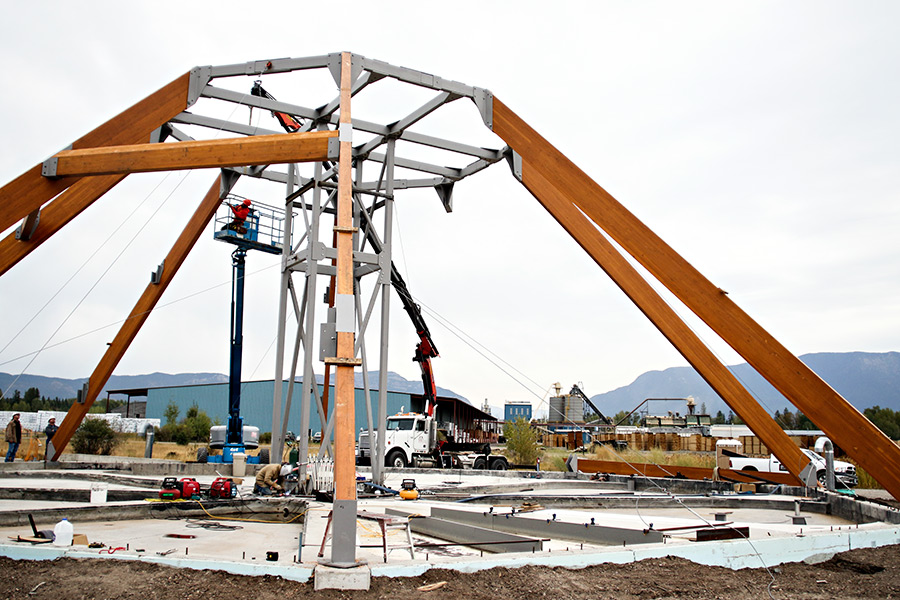Green Power House Rises from the Ashes
After a devastating fire set the Columbia Falls-based energy company back one year, Algae Aqua-Culture Technologies starts anew
By Tristan Scott
When a structure fire destroyed the futuristic-looking octagonal dome in Columbia Falls, where Algae Aqua-Culture Technologies housed its cutting-edge energy system, the devastating setback cast doubt on the company’s bright future.
Nine months later, and the company has begun reconstruction of its green powerhouse, having leveraged the bout of misfortune into opportunity while building on a new partnership to improve the innovative energy technology at its facility on property owned by F.H. Stoltze Land and Lumber Co.
Michael Smith is president and co-founder of Algae Aqua-Culture Technologies Inc. (AACT) and, along with other scientists, has engineered a system that uses industrial waste, like wood chips from the lumber manufacturing process at Stoltze, to cultivate algae and convert it into electricity-generating methane.
The technology, Smith said, will help reduce the carbon footprint of polluting industries like timber and coal while providing cleaner, low-carbon energy alternatives and lucrative new revenue streams.
The process also yields a valuable byproduct in the form of nutrient-rich soil amendments and high-grade organic fertilizer, the markets for which are growing rapidly, Smith said.
AACT had been operating the demonstration-scale greenhouse on Stoltze land for several years while shipping its product to companies nationwide, and was on the cusp of bringing the technology to a widespread commercial-scale level after years of work.
So when a fire destroyed the main powerhouse on Jan. 24, the alternative energy company immediately began looking at how to recover from the loss and move forward with plans to redesign and streamline the destroyed prototype unit.
Smith, a mathematician, physicist and former software engineer in San Francisco, said the fire in January set the company back a full year, but it also offered an opportunity to tweak its technology and infrastructure, making it more efficient.
To that end, AACT partnered with Acutech, a Columbia Falls-based supply chain manufacturer, which built the powerhouse’s carbon engine as well as all of its 304 stainless components. Using precision water jet and laser cutting, the parts were machined, MIG welded and fabricated at the company’s 16,000-square-foot facility.
Now that the planning and actual fabrication of the prototype greenhouse unit is complete, construction is underway in earnest on the Stoltze property, and the process must be tested and streamlined, at which point AACT hopes to expand to other lumber mills and larger facilities. The project is putting Montana on the map for renewable energy source hot spots, Smith said.
Called a Green Power House, the Algae Aquaculture Technology structure resembles a geodesic Lego dome, and the floor is divided into pools in which the algae are grown.
The pools are actually raceway systems designed to optimize the cultivation and harvesting of algae and, because it takes eight days for an individual pool to grow the algae, one pool is harvested daily.
Carbon dioxide, normally considered an industrial pollutant, is captured and used as a nutrient for the algae as well as some of the nitrogen-rich byproduct from the bioreactors. The algae are then fed into geothermal-heated bioreactors that consume the organic matter and produce methane, which is converted into electricity.
It’s basically a sophisticated form of composting, and Smith likens the bioreactor to a “mechanical buffalo.”
Among the changes to the design, Smith said, is a lower cost and faster assembly method, as well as safety improvements and a 25 percent increase in capacity.
Smith said the new powerhouse should be operational within a few months, and he hopes to build three additional facilities on the six acres of Stoltze land. The lumber company has a 10 percent ownership stake in the project, and the benefits to Stoltze are manifold since the company can convert its waste wood and heat into synthetic gas and electricity to power the plant.
AACT received its initial funding through a $350,000 grant from the Montana Department of Environmental Quality, and is optimistic that industry will begin adopting the clean, green algae technology on a widespread basis, though he admits that “we are a nation of late adopters.”
For more information on AACT’s facility and process, visit www.algaeaqua.com. For more information on Acutech, visit www.acutechworks.com.